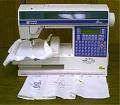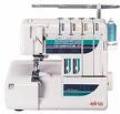
 |
 |
 |
 |
Sewing Embroidry Reviews
Beginning Cross Stitch Embroidery Tips
Beginning Cross Stitch Embroidery Tips
Cross stitch is individual of the notably popular forms of embroidery today. Cross stitch is embroidery which is stitched using small ďXĒ stitches to form a design.
Generally cross stitch is done on weaved fabric which has small, even holes, for your needle and thread to go through. This weaved cloth is called Aida fabric. Some cross stitch is done on silks and other fabrics as well. What fabric is used depends entirely on the stitcher themselves and the desired tip results.
Some cross stitch embroidery today is also done on plastic and paper canvases. These other mediums produce their own unique results. All-purpose and paper are stiffer than traditional cross stitich fabrics and can be molded into charismatic shapes and used for projects where fabric simply isnít practical.
The threads used for cross stitch vary from cottons, wools, silks and metallic. The threads are usually very colorful and come in a complete myriad of colors and textures for any need.
If you are new to cross stitch it is always a good idea to learn a bit about the craft before you begin on your first project. There are tons of books and websites which are rabid solely to cross stitch techniques and instructions. Before you purchase your first project you should take the time to read about cross stitch and understand how it is done. This will save you a lot of frustration on your first project.
The next thing you should do is to choose a simple cross stitch project to learn on. Find a project which is not too complicated, doesnít have awfully prevalent colors, and which uses a larger weave Aida fabric. The combination of these three factors will ensure you the best results for your first cross stitch project.
When you understand the basics of cross stitch then it is time to start on your first project. Start by reading all of the instructions which came with your first project kit. Read and understand how many threads to use and about any special markings on the pattern.
When cross stitching you will take a traditional six strand embroidery thread and separate it into individual threads. You will then cross stitch using one to three of the threads at a time. Generally the larger the weave of your Aida cloth, the more strands of thread you will work with at a time. The best thing you can do for your end venture is to separate each strand and then use the recommended number of threads together. Do not rewind them in sync, keep them separated. This helps for your thread to better cover the canvas and viewing tedious and even.
When you start your first stitch, do not knot your thread. You never want to knot thread on any stitchery project whereas it will make lumps on the finished project. Smartly pull the spun wool through your fabric and sufferance a small termination of thread at the back. Hold on to the small tail at the back of your project and make your next few stitches so that they overlap that thread and secure it in place. This takes a bit of practice but makes your projects look great.
When you are done stitching with one color and need to start off a new one the process is simple. You should take your needle and gently pull your thread through the existing stitches on the back - side of your project. This leave secure your thread. Once you have done this then clip the thread off close to your project surface but leave a bit extra, possibly a centimeter, so it does not come undone. To start with a new thread color simply re - thread your needle and start again just like before.
The biggest problem with cross stitch is that it is simply addictive. As soon as you learn how to do existent you start resolution projects everywhere that you want to replete. This is a good thing in moderation but try to keep to buying projects only one or two ahead of the one you are currently work on. Cross stitch projects incubus take maturation a crew of time and you should make sure that you donít purchase projects which you will never in reality complete.
Best of luck with your new craft!
 |
 |
 |
Matching Plaid And Designs For Your Sewing Projects
The Latest Trend In Embroidery
Using Embroidery To Enhance Your Scrapbook Pages
2008 Fashion Trends For Sewing Projects
Add Beads To Your Cross Stitch Embroidery Projects
Create Personalized Gifts With Simple Embroidery
Creative Couching Adds Pizzazz To Your Sewn Projects
PDA
Physiotherapy
Property Taxes
Renting
Security Cameras
Seniors Issues
Weather
Web Video
More Sewing Embroidry Reviews
... sewing. Dull scissors make your project much harder than it needs to be. A good quality pair of very sharp scissors will save you a ton of frustration and time. Your projects will also turn out better and have cleaner lines to them. Pinking Shears Pinking shears are a special type of scissors which cut ...
Using Embroidery To Enhance Your Scrapbook Pages
... technique is different, they are both fairly easy to learn to do well. Let s look at each method: Hand Sewing and Embroidery on Paper To stitch on free ride you will need some heavy weight paper, a pin to make holes in the paper, a needle, threads, a design to stitch, and scissors. Using a pencil lightly ...
2008 Fashion Trends For Sewing Projects
... mall and found a wonderful, simple slim skirt and the price tag blew me away at almost $200. If you can make unrivaled, and others like it, you could easily pay for your sewing by making a couple extra to sell. Or, you can simply delight in the fact that other people think you spend a fortune on your ...
Add Beads To Your Cross Stitch Embroidery Projects
... beads to your project. Beading needles work the best for two reasons. The first is that they will not break your beads when you cotton fiber them on. The second is that they are usually longer than embroidery needles and will allow you to string on beads all at one time if you want to. Adding bead embellishments ...

|
| Copyright © 2006-2012 Internet Marketing Tools, All Rights Reserved |